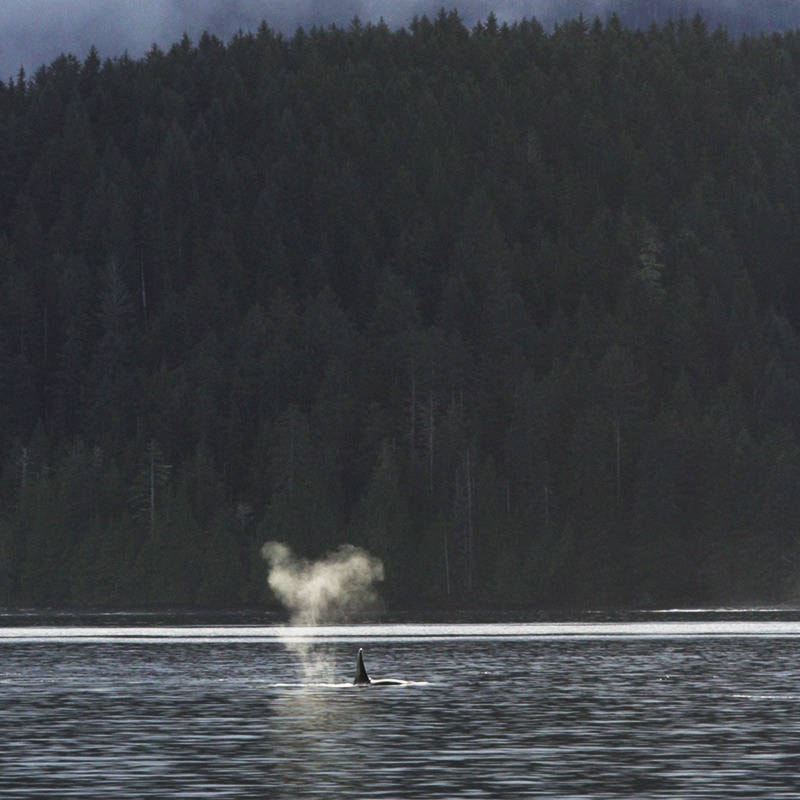Why build a sewage plant up a steep, rocky slope when the stuff could be piped to an existing plant in Skidegate?
That was the big question for Queen Charlotte council last week. It was asked twice during the final public meeting before the village votes “yes” or “no” to buying a 78-acre, $625,000 hillside property for its own sewage treatment plant.
“The answer is cost,” said Mayor Greg Martin.
“If you don’t like the cost of this, you’re going to hate the cost of that.”
According to planning-level engineering studies done in 2010 and 2013, Martin said it could cost up to $4 million more for Queen Charlotte to hook up with the Skidegate system rather than build its own sewage plant on the proposed site at 4603 Martynuik Road.
For one thing, he said, the Skidegate plant would need costly upgrades to handle the added flow from Queen Charlotte.
But Ruth Wheadon, a member of the “no” campaign who lives near the Martynuik Road property, said the difference would likely be less than $4 million.
That’s because a new plant would have several unknown costs, she said, including a very steep access road, extra pumps and pipes, a three-phase power hook-up, and blasting to make level ground.
“I do admit I’m not a risk-taker,” Wheadon said.
“I prefer known costs to unknown costs.”
Staff and councillors with the Village of Queen Charlotte agree that the steep property for sale is not ideal — of the 12 siting criteria set out by Opus, the engineering firm that did the 2010 and 2013 studies, the village says it passes 11 but fails the one suggesting the plant be built near sea level to minimize pumping. The area where the new plant would be built is about 120 metres above the existing sewer network.
But based on available estimates, Queen Charlotte council still believes it is the least-costly option.
Besides unknown costs, the Martynuik Road site also has unknown benefits — council hopes the village can sell some lower portions of the property for a small housing development.
As the largest fee-simple property available in Queen Charlotte, Martin said it’s the best suited for having a wide tree buffer to stop odours or noise from bothering the neighbours.
Just one of the blue “Vote No” campaign buttons was left at the counter of the Queen Charlotte gas station before the meeting last Thursday.
Tracy Morton, a Queen Charlotte resident, noted that many people at the meeting seemed to be “No” supporters.
If that’s how the vote goes on Feb. 24, Morton asked what Queen Charlotte councillors will do about the 2009 Environment Canada order that required the village to quit pumping untreated sewage into Skidegate Inlet or face fines and other penalties?
“Are we allowed to park this for another five, 10 years before something happens?” Morton asked.
Martin replied that if people do vote “no,” Queen Charlotte council will indeed look at tying into the Skidegate system, even if it is more expensive. There is also the possibility that more land may come up for purchase, and council is already applying to push back the federal deadline of 2020 for taking action.
One option that is not on the table, at least for the current council, is expropriating land.
Resident Duncan White said while he knows it’s distasteful, he wanted to know if council would consider expropriation to get the best possible property for a Queen Charlotte sewage plant
“Ouch,” said Martin. “You’re correct, it is legally possible. But I don’t have any appetite for that.”
White also asked if council had ever looked at cost estimate of building a sewage treatment plant in the industrial zone west of Queen Charlotte, and then pumping the treated effluent back east, to an outfall in the deeper water where it needs to be?
Ben Greenough, Queen Charlotte’s superintendent of public works, said the idea did come up before the 2010 study was done, but it was dismissed as way too expensive — it would mean digging up and reversing the flow of the existing sewage system.
“In my opinion, when you’re paying engineers those crazy hourly rates and they say, ‘Don’t waste your money on that study because it’s too expensive,’ I think it was a wise decision not to look into that.”
If the referendum to buy the land does pass, Queen Charlotte residents can expect a tax increase of $29.79 per $100,000 of residential property value, or $67.71 for every $90,000 of business property. From planning to construction, the new plant could take anywhere from 10 to 15 years to get up and running.
Whatever the result, Queen Charlotte councillors say their main goal is to have a referendum with a high voter turnout, and residents who are making an informed choice based on accurate, unbiased information.
General voting will run from 8 a.m. to 8 p.m. on Saturday, Feb. 24 in the Eric Ross Room of the Queen Charlotte Community Hall.
